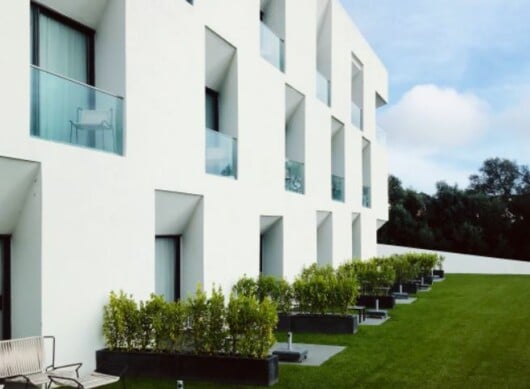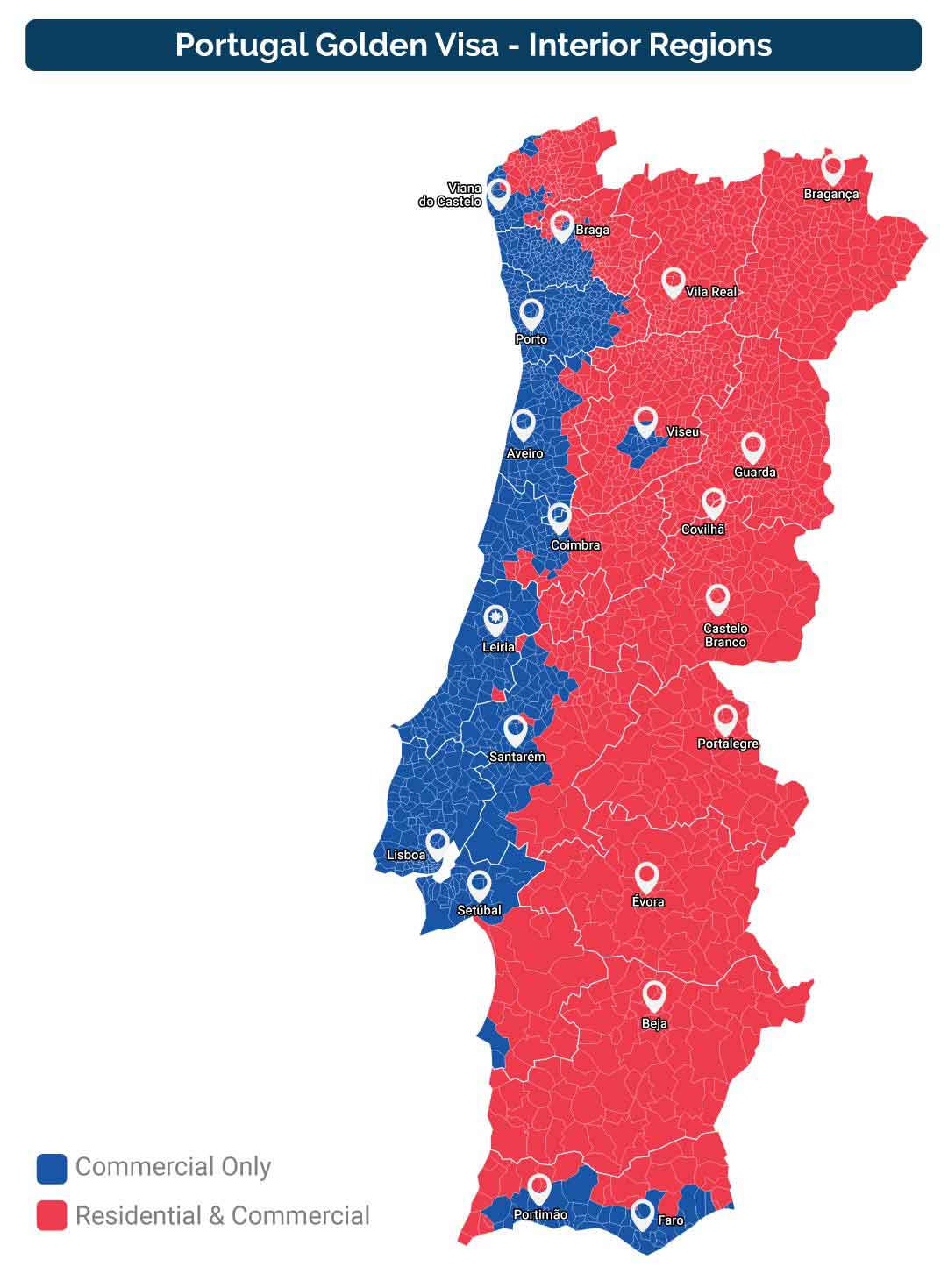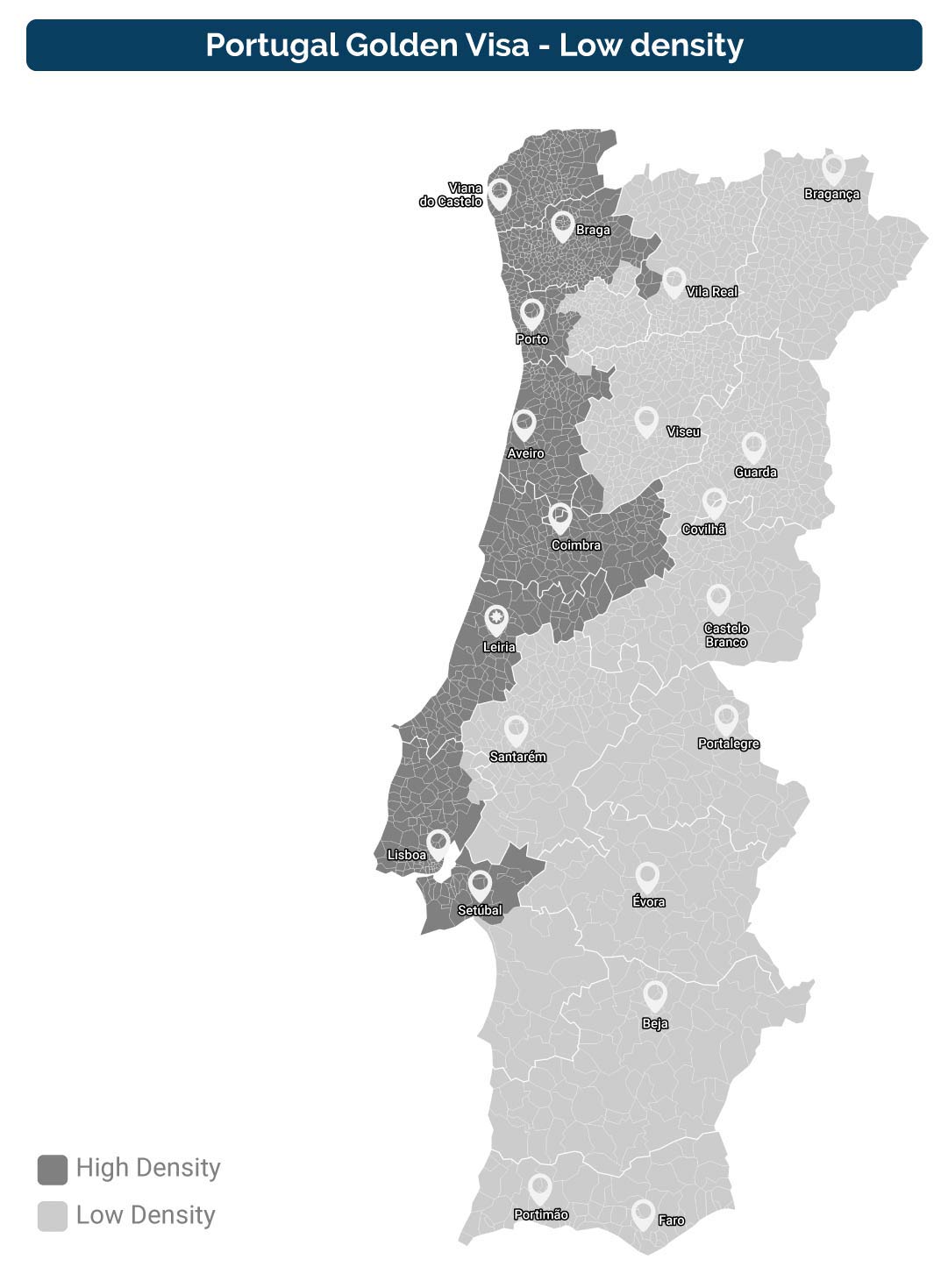Updated: April 23, 2024
Portugal matches today’s definition of luxury: authenticity, innovation, and creativity. This is especially true with regard to commercial properties and residential real estate investment opportunities in low-density areas of the country. Investors and the media never tire of “discovering” this part of Portugal that surprises visitors — the off-the-beaten part of the country that provides ample opportunities to invest in property. Indeed, there’s a broad range of opportunities on offer to invest in Portugal low density areas, with more and more investors scrambling to tap into this wealth of opportunity.
Why invest in Portugal? And why in one of the country’s low-density areas? This guide will provide you with more information about low-density and interior areas of Portugal and what makes them stand out as highly desirable locations.
Important Update on the Portugal Golden Visa, October 2023
Significant changes were implemented concerning the Portugal Golden Visa, and it’s essential to understand that real estate investments no longer qualify as an option within the program, including investing in interior or low-density areas.
However, several other attractive investment routes remain eligible for the program. For detailed information, please consult the Portugal Golden Visa Ultimate Guide provided by our residency and citizenship division, Global Citizen Solutions.
While real estate has traditionally been the most favored investment pathway, it’s no longer available. Investors seeking alternative options to qualify for the Golden Visa are increasingly turning to the investment fund route. More details on this pathway can be found in the Portugal Golden Visa Investment Fund guide.
Current Golden Visa Options
Investments in real estate are no longer an option. However, there remain several attractive options on the table, which you will find detailed below.
- Fund Subscription: Contribute a minimum of €500,000 to a certified investment fund.
- Arts or Heritage Reconstruction Contribution: Contribute at least €250,000 towards the arts or the restoration of national heritage. Note that if the project takes place in low-density areas (see map below), then a 20 percent discount will apply.
- Scientific Research: Contribute €500,000 or more to research in the field of science or technology.
- Job Creation: Generate and sustain ten positions over the specified period.
- Share Capital and Job Creation: Establish a company or strengthen its share capital with an investment of €500,000, combined with the creation of five jobs or the maintenance of ten (with at least five being permanent).
Interior areas
This map highlights Portugal’s interior regions.
Low density areas
Low-density areas are defined as territorial units (NUTS III) that have less than 100 inhabitants per square km or a GDP per capita that is less than 75 percent of the national average. Low-density areas determine whether a 20 percent discount rate is applicable to your investment or not.
Low-density areas are shown in light grey below (areas that fall outside the low-density zone are shown in dark grey).
Interior and low-density Residential Real Estate
Although you can no longer qualify for the Golden Visa with a real estate investment, interior and low-density areas still present an attractive investment opportunity – such as the Douro Valley, Aljezur, and Peneda Gerês.
Each of these offers excellent, spacious properties that are very good value for money. You will be able to find properties with a private swimming pool and large areas of land for roughly €400K.
| Reselling chances | Prices per m2 | Prices fluctuation | Tourism industry | Renting returns | Tourism returns | |
| Peneda Gerês | Medium | Low | Low | High | Low | High |
| Douro Valley | Medium | Medium | Low | Medium | Low | Medium |
| Aljezur | High | High | Low | High | Medium | High |
Advantages of Investing in Low-Density Areas
- Affordable properties, with the opportunity to earn high rental returns.
- In low-density areas, investors are likely to find much bigger and better properties with two to three units to rent.
- Profitability is around €12.000 per year, which makes the case for owning several units quite attractive.
- As the capital needed to invest is low, investors have more freedom for other business investments.
- Away from the crowds, these low-density areas of Portugal are great for new beginnings and offer a high quality of life.
- Cities in the interior of Portugal are becoming popular with students and, as the young population grows in these cities, the need and opportunity to serve them intensifies
- European and local investors buy in these areas.
- Yearly growth of five percent
- Promising areas to develop eco-tourism, wellness, innovation, and luxury projects.

Other Excellent Low-Density Areas to Invest in Portugal
Peneda-Gerês, the Douro Valley, and Alentejo are pristine low-density areas for investment in Portugal that are popular with tourists.
Gerês is one of the favorite regions for investors due to its dense and wonderful Peneda Gerês National Park. It is an incredible place. The famous waterfalls are paradisiacal and a rarity in Europe.
Classified as a World Heritage Site by UNESCO, the Douro Region is one of the most acclaimed areas in the world due to its untouched natural landscapes.
Invest in Portugal: Full list of low-density areas
The full list of 165 counties and 72 parishes that are categorized as low-density are outlined below.
City/ Municipality Neighborhoods Neighborhoods
Águeda
Amarante
Gouveia (São Simão)
Rebordelo
União das freguesias de Aboadela, Sanche e Várzea
União das freguesias de Bustelo, Carneiro e Carvalho de Rei
Jazente
Salvador do Monte
União das freguesias de Olo e Canadelo
Vila Chã do Marão
Amares
União das freguesias de Caldelas, Sequeiros e Paranhos
União das freguesias de Vilela, Seramil e Paredes Secas
Caminha Dem
Castelo de Paiva
União das Freguesias da Raiva, Pedorido e Paraíso Real
-
Condeixa-a-Nova Furadouro -
Guimarães União das freguesias de Arosa e Castelões -
Loulé Alte
SalirAmeixial
União de freguesias de Querença, Tôr e Benafim
Marco de Canaveses Várzea, Aliviada e Folhada -
Ourém
União das freguesias de Freixianda, Ribeira do Fárrio e Formigais
Anais
Ponte de Lima Ardegão, Freixo e Mato
Bárrio e Cepões
Boalhosa
Cabração e Moreira do Lima
Estorãos
Gemieira
Labruja
Navió e Vitorino dos Piães
Serdedelo Associação de freguesias do Vale do Neiva
Beiral do Lima
Cabaços e Fojo Lobal
Calheiros
Friastelas
Gondufe
Labrujó, Rendufe e Vilar do Monte
Poiares
-
Porto de Mós São Bento -
Santarém -
Silves São Marcos da Serra -
Tavira Cachopo Santa Catarina da Fonte do Bispo
Tomar
União das freguesias de Além da Ribeira e Pedreira
União das freguesias de Serra e JunceiraSabacheira
União das freguesias de Casais e Alviobeira
–
Vale de Cambra Arões Junqueira
Valença Boivão
União das freguesias de Gondomil e Safins Fontoura
União das freguesias de São Julião e Silva
Low-density counties in Portugal:
1. Abrantes
2. Aguiar da Beira
3. Alandroal
4. Alcácer do Sol
5. Alcoutim
6. Alfândega da Fé
7. Alijó
8. Aljezur
9. Aljustrel
10. Almeida
11. Almodôvar
12. Alter de Chão
13. Alvaiázere
14. Alvito
15. Ansião
16. Arcos de Valdevez
17. Arganil
18. Armamar
19. Arouca
20. Arraiolos
21. Arronches
22. Avis
23. Baião
24. Barrancos
25. Bej
26. Belmonte
27. Borba
28. Boticas
29. Bragança
30. Cabeceiras de Basto
31. Campo Major
32. Carrazeda de Ansiães
33. Carregal do Sal
34. Castanheira de Pêra
35. Castelo Branco
36. Castela de Vide
37. Castro Daire
38. Castro Marim
39. Castro Verde
40. Celorico da Beira
41. Celorico de Basto
42. Chamusca
43. Chaves
44. Cinfães
45. Constância
46. Coruche
47. Covil
48. Crato
49. Cuba
50. Elvas
51. Estremoz
52. Évora
53. Fafe
54. Ferreira do Alentejo
55. Ferreira do Zêzere
56. Figueira de Castelo Rodrigo
57. Figueiró dos Vinhos
58. Fornos de Algodres
59. Freixo de Espada à Cinta
60. Fronteira
61. Fundão
62. Gavião
63. Góis
64. Gouveia
65. Grândola
66. Guarda
67. Idanha-a-Nova
68. Lamego
69. Lousã
70. Marção
71. Macedo de Cavaleiros
72. Mangualde
73. Manteigas
74. Marvão
75. Meda
76. Melgaço
77. Mértola
78. Mesão Frio
79. Miranda do Corvo
80. Miranda do Douro
81. Mirandela
82. Mogadouro
83. Moimenta da Beira
84. Monção
85. Monchique
86. Mondim de Basto
87. Monforte
8. Montalegre
89. Montemor-o-Novo
90. Mra
91. Mortágua
92. Moura
93. Mourão
94. Murça
95. Nelas
96. Nisa
97. Odemira
98. Oleiros
99. Oliveira de Frades
100. Oliveira o Hospital
101. Ourique
102. Pampilhosa da Serra
103. Paredes de Coura
104. Pedrógão Grande
105. Penacova
106. Penalva do Castelo
107. Penamacor
108. Penedono
109. Penela
110. Pedo da Régua
111. Pinhel
112. Ponte da Barca
113. Ponte de Sor
114. Portalegre
115. Portel
116. Póvoa de Lanhoso
117. Proença-a-Nova
118. Redondo
119. Reguengos de Monsaraz
120. Resende
121. Ribeira de Pena
122. Sabrosa
123. Sabugal
124. Santa Comba Dão
125. Santa Marta de Penaguião
126. Santiago de Cacem
127. São João da Pesqueira
128. São Pedro do Sul
129. Sardoal
130. Sátão
131. Seia
132. Sernancelha
133. Serpa
134. Sertã
135. Server do Vouga
136. Soure
137. Sousel
138. Tábua
139. Tabuaço
140. Tarouca
141. Terras de Bouro
142. Tondela
143. Torre de Moncorvo
144. Trancoso
145. Valpaços
146. Vendas Novas
147. Viana do Alentejo
148. Vidigueira
149. Vieira do Minho
150. Vila do Rei
151. Vila do Bispo
152. Vila Flor
153. Vila Nova da Barquinha
154. Vila Nova de Cerveira
155. Vila Nova de Foz Côa
156. Vila Nova de Paiva
157. Vila Nova de Poiares
158. Vila Pouca de Aguiar
159. Vila Real
160. Vila Velha de Ródão
161. Vila Verde
162. Vila Viçosa
163. Vimioso
164. Vinhais
165. Vouzela
Low-density parishes in Portugal:
Águeda
União das freguesias de Belazaima do Chão, Castanheiro do Vouga e Agadão
União das freguesias do Préstimo e Macieira de Alcoba
Amarante
Ansiães
Candemil
Gouveia (São Simão)
Jazente
Rebordelo
Salvador do Monte
União das freguesias de Aboadela, Sanche e Vázea
União das freguesias de Bustelo, Carneiro e Carvalho de Rei
União das freguesias de Olo e Carnadelo
Vila Chã de Marão
Amares
Bouro (Santa Marta)
Goães
União das freguesias de Caldelas, Sequeiros e Paranhos
União das freguesias de Vilela, Seramil e Paredes Secas
Caminha
Dem
União das freguesias de Arga (Baixo, Cima, e São João)
União das freguesias de Gondar e Orbacém
Castelo de Paiva
Real
Condeixa-a-Nova
Furadouro
Guimarães
União das freguesias de Arosa e Casteiões
Loulé
Alte
Ameixial
Salir
União das freguesias de Querença, Tôr e Benafim
Marco de Canaveses
Várzea, Aliviada e Folhada
Ourém
Espite
União das freguesias de Freixianda, Ribeira do Fárrio e Formigais
União das freguesias de Matas e Cercal
União das freguesias de Rio de Couros e Casal dos Bernados
Pompal
Abiul
Ponte de Lima
Anais
Ardegão, Freixo e Mato
Associacão de freguesias do Vale do Neiva
Bárrio e Cepões
Beiral do Lima
Boalhosa
Cabaços e Fojo Lobal
Cabração e Moreira do Lima
Calheiros
Estorãos
Friastelas
Gemieira
Gondufe
Labruja
Labrujó, Rendufe, e Vilar do Monte
Navió e Vitorino dos Piães
Poiares
Serdedelo
Porto de Mós
São Bento
Santarém
União das freguesias de Casével e Vaqueiros
Silves
São Marcos da Serra
Tavira
Cachopo
Santa Catarina da Fonte do Bispo
Tomar
Olalhas
Sabacheira
União das freguesias de Além da Ribeira e Pedreira
União das freguesias de Casais e Alviobeira
União das freguesias de Serra e Junceira
Vale de Cambra
Arões
Junqueira
Valença
Boivão
Fontoura
União das freguesias de Gondomil e Safins
União das freguesias de São Julião e Silva
Viana do Castelo
Montaria
Viseu
Calde
Cavernães
Cota
Ribafeita
São Pedro de France
União das freguesias de Barreiros e Cepões
Get in Touch
If you have found your dream property in Portugal, seek help from a specialized property investment firm such as Goldcrest. Whether you are simply looking to buy Portugal land or a luxury home with waterfront views, we are here to help. Experienced professionals guarantee purchase advantages, and work through the requirements, hidden costs, and fine print smoothly and efficiently.
Contact the Goldcrest team to access exclusive information on the property market in Portugal and find out how much you can save on your international investment.
Frequently Asked Questions about Low-density Areas in Portugal
What are the low-density areas I can invest in?
It is no longer possible to invest in low-density areas and qualify for the Portugal Golden Visa.
How much do I need to invest in a low-density area?
It is no longer possible to invest in low-density areas and be eligible for the Golden Visa in Portugal.
Can I get residency if I invest in real estate in a low-density area?
No, it is no longer possible to secure residency by investing in Portuguese real estate under the Portugal Golden Visa.
What are low density areas?
A region is considered to be a “low-density area” if it has fewer than 100 people per square kilometer or a per capita GDP that is less than 75 percent of the national average.
In terms of real estate, low density refers to the ratio of dwelling units to pieces of land in a specific area. Low-density housing often refers to areas that are mostly made up of single-family houses or modestly-sized buildings.
Is Setubal a low density area?
It is. The Douro Valley, Evora, certain regions of the Algarve, and Setubal are all categorized as low-density areas.
Is Braga a low density area?
Yes, it is. And there are Viseu, Leiria, Santarém, Viana do Castelo, Aveiro, a few Porto neighborhoods, and parts of Coimbra among other popular locations in the country.
What is a Portuguese urban regeneration area?
Portuguese urban regeneration areas contain buildings that are bought at relatively cheap prices, redone, and then rented out. These are key investment areas that can reap financial rewards, as you can generally expect high returns on your investment.




